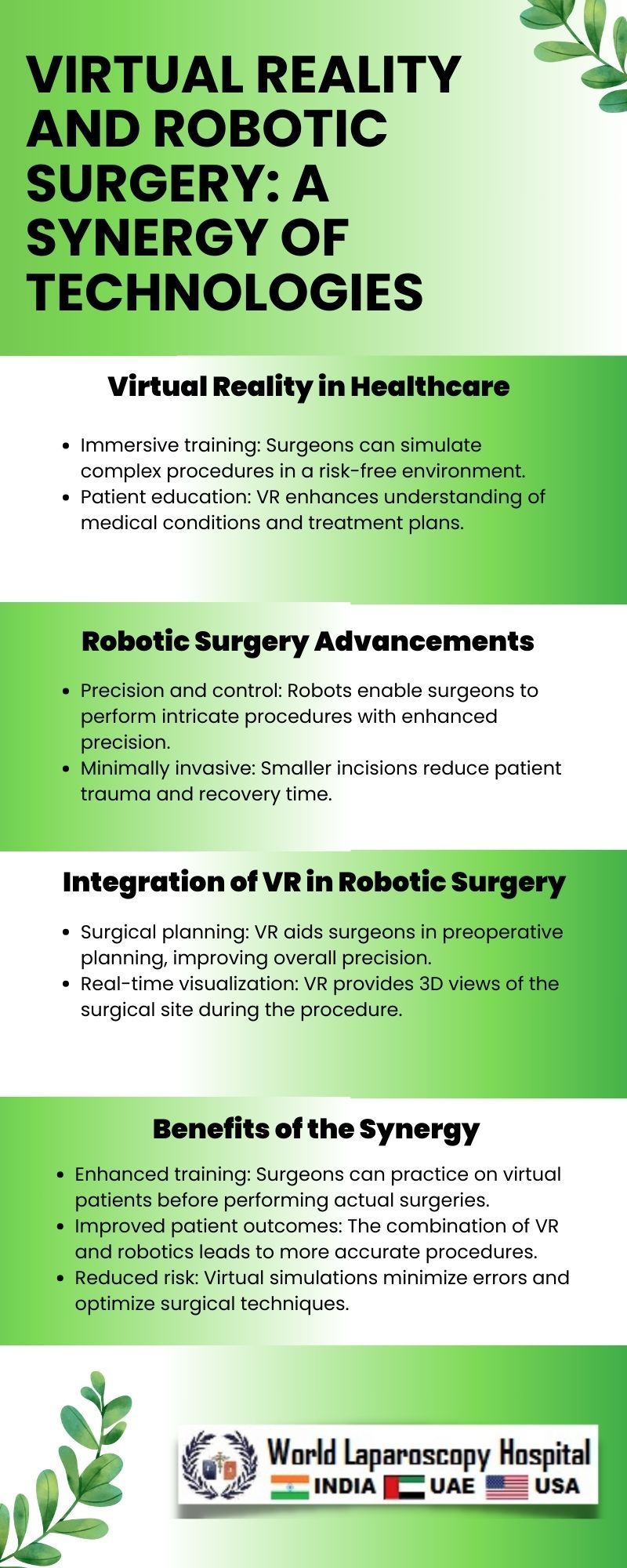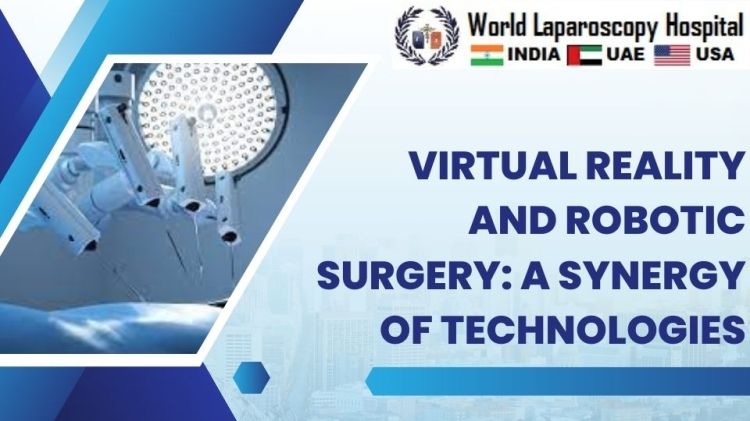Virtual Reality and Robotic Surgery: A Synergy of Technologies
Introduction:
The intersection of Virtual Reality (VR) and Robotic Surgery has ushered in a new era in the field of medicine, revolutionizing the way surgeries are performed and healthcare is delivered. As technology continues to advance, the synergy between these two cutting-edge technologies has the potential to redefine the landscape of surgical procedures, enhance medical training, and improve patient outcomes. In this article, we will explore the convergence of Virtual Reality and Robotic Surgery, examining the current state of affairs, the challenges faced, and the promising future that lies ahead.

The Evolution of Robotic Surgery:
Robotic Surgery has come a long way since its inception. The introduction of da Vinci Surgical System in the early 2000s marked a paradigm shift in the field, providing surgeons with enhanced precision, dexterity, and visualization during minimally invasive procedures. The robotic arms, controlled by the surgeon from a console, allowed for more intricate maneuvers and reduced the invasiveness of surgeries. However, despite these advancements, there were still limitations in terms of haptic feedback and the surgeon's immersive experience.
The Rise of Virtual Reality in Medicine:
Simultaneously, Virtual Reality has been making significant strides in healthcare. VR technology creates immersive and interactive simulated environments, offering unprecedented opportunities for medical training, patient education, and preoperative planning. Medical professionals can now visualize complex anatomical structures in 3D, enhancing their understanding and decision-making processes. The immersive nature of VR also makes it an invaluable tool for patient education, allowing individuals to explore their own anatomy and comprehend the intricacies of their medical conditions.
Synergies in Surgical Training:
One of the most compelling aspects of the synergy between VR and Robotic Surgery lies in the realm of surgical training. Traditional surgical training often relies on cadaveric specimens and observation of live surgeries. With VR, aspiring surgeons can engage in realistic simulations, replicating surgical scenarios with haptic feedback. This not only accelerates the learning curve but also provides a risk-free environment for trainees to hone their skills.
Incorporating robotic platforms into these virtual simulations adds another layer of complexity. Trainees can practice controlling robotic arms and manipulating instruments in a controlled environment, preparing them for the challenges they may encounter in real surgical settings. This fusion of VR and robotic technology bridges the gap between theoretical knowledge and practical application, creating a more proficient and confident generation of surgeons.
Enhanced Surgical Planning:
Virtual Reality facilitates detailed preoperative planning by allowing surgeons to immerse themselves in a 3D reconstruction of the patient's anatomy. This not only aids in understanding the spatial relationships between structures but also enables surgeons to anticipate potential challenges before entering the operating room. The integration of patient-specific imaging data into VR environments provides a personalized and accurate representation, fostering a more precise surgical plan.
When combined with robotic surgery, the surgeon can use the VR model to practice and refine their approach, optimizing the use of robotic instruments and ensuring a seamless execution of the procedure. This integration minimizes the element of surprise during surgery, ultimately leading to better outcomes and reduced complications.
Overcoming Challenges: Haptic Feedback and Latency:
Despite the immense potential, the integration of Virtual Reality and Robotic Surgery is not without challenges. One significant hurdle is the limitation of haptic feedback in both technologies. Haptic feedback, the sense of touch and force feedback, is crucial in surgery to gauge tissue resistance and apply the right amount of force. Current robotic systems often lack the fidelity of haptic feedback, making it challenging for surgeons to fully replicate the tactile sensations experienced in traditional surgery.
The latency in VR systems is another obstacle. Any delay between the surgeon's input and the corresponding action in the virtual or robotic environment can be detrimental, affecting precision and real-time decision-making. Researchers and engineers are actively working to address these challenges, developing haptic interfaces that provide more realistic feedback and minimizing latency to ensure a seamless and responsive experience for the surgeon.
Remote Surgery and Telemedicine:
The fusion of VR and Robotic Surgery opens up new possibilities in the realm of remote surgery and telemedicine. Surgeons can potentially perform complex procedures from a distant location using robotic systems, guided by immersive VR environments. This is particularly valuable in scenarios where specialized surgical expertise is not locally available, bringing high-quality healthcare to underserved areas.
However, the implementation of remote surgery raises ethical and regulatory considerations. Ensuring patient safety, data security, and adherence to legal frameworks are critical aspects that need to be addressed before remote surgeries become commonplace. Additionally, the reliability and stability of communication networks are pivotal for the success of remote surgical procedures.
The Future of Healthcare: Patient-Centric and Precision Surgery:
As the synergy between Virtual Reality and Robotic Surgery advances, the future of healthcare holds the promise of patient-centric and precision surgery. Personalized treatment plans, based on detailed virtual reconstructions of individual anatomy, will become the norm. Surgeons will have access to a wealth of patient-specific data, enabling them to tailor interventions to the unique characteristics of each case.
The integration of artificial intelligence (AI) further enhances the capabilities of these technologies. AI algorithms can analyze vast datasets, assist in surgical planning, and provide real-time insights during procedures. This collaborative interaction between surgeons, VR, robotics, and AI creates a dynamic and intelligent surgical ecosystem, paving the way for unprecedented levels of precision and efficiency in healthcare delivery.
Ethical Considerations and the Human Touch:
While the technological advancements in Virtual Reality and Robotic Surgery are undeniably transformative, ethical considerations must not be overlooked. The human touch, empathy, and the doctor-patient relationship remain integral to healthcare. Striking a balance between technological innovation and preserving the human connection is crucial to ensure that patients receive not only technically proficient care but also compassionate and empathetic support.
Furthermore, questions surrounding the potential dehumanization of healthcare, the impact on employment for traditional surgical staff, and the equitable distribution of advanced medical technologies must be carefully addressed. Ethical guidelines and regulations should be in place to navigate the evolving landscape of medical technology responsibly.
Conclusion:
The convergence of Virtual Reality and Robotic Surgery marks a pivotal moment in the evolution of medicine. This synergy has the potential to reshape surgical practices, redefine medical education, and improve patient outcomes. As technology continues to advance and researchers overcome the current challenges, the future holds exciting possibilities for a healthcare system that is more personalized, precise, and accessible than ever before. The journey towards this future requires collaboration between healthcare professionals, engineers, ethicists, and policymakers to ensure that the integration of these technologies is not only technically sophisticated but also ethically sound and human-centric. In the coming years, the marriage of Virtual Reality and Robotic Surgery will undoubtedly continue to push the boundaries of what is possible in the field of medicine, ultimately benefiting patients and advancing the frontiers of surgical innovation.






